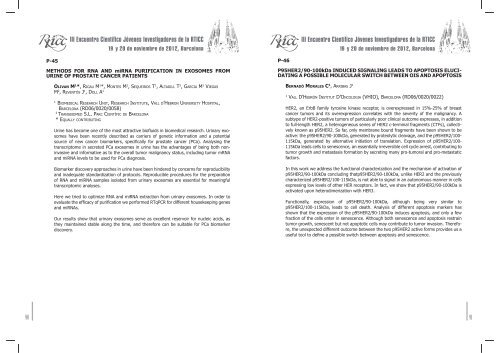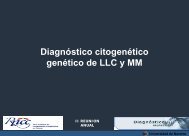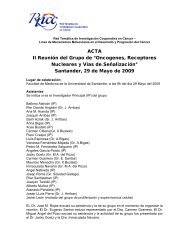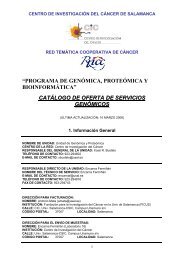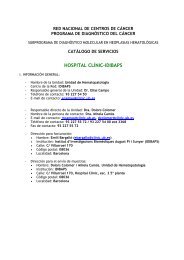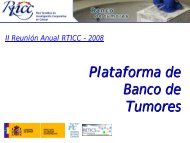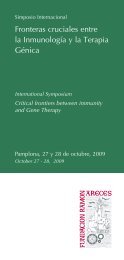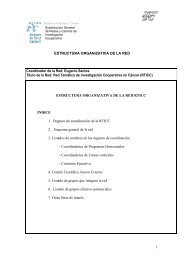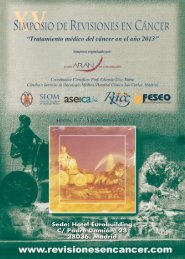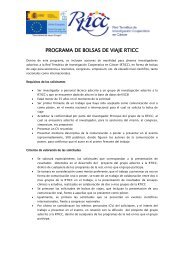Untitled - Red Temática de investigación cooperativa en cáncer
Untitled - Red Temática de investigación cooperativa en cáncer
Untitled - Red Temática de investigación cooperativa en cáncer
You also want an ePaper? Increase the reach of your titles
YUMPU automatically turns print PDFs into web optimized ePapers that Google loves.
P-45<br />
METHODS FOR RNA AND miRNA PURIFICATION IN EXOSOMES FROM<br />
URINE OF PROSTATE CANCER PATIENTS<br />
OLIVAN M 1 *, RIGAU M 1 *, MONTES M 1 , SEQUEIROS T 1 , ALTADILL T 2 , GARCIA M 1 VIEGAS<br />
M 2 , REVENTÓS J 1 , DOLL A 1<br />
1<br />
BIOMEDICAL RESEARCH UNIT, RESEARCH INSTITUTE, VALL D’HEBRON UNIVERSITY HOSPITAL,<br />
BARCELONA (RD06/0020/0058)<br />
2<br />
TRANSBIOMED S.L. PARC CIENTÍFIC DE BARCELONA<br />
* EQUALLY CONTRIBUTING<br />
Urine has become one of the most attractive biofluids in biomedical research. Urinary exosomes<br />
have be<strong>en</strong> rec<strong>en</strong>tly <strong>de</strong>scribed as carriers of g<strong>en</strong>etic information and a pot<strong>en</strong>tial<br />
source of new cancer biomarkers, specifically for prostate cancer (PCa). Analysing the<br />
transcriptome in secreted PCa exosomes in urine has the advantages of being both noninvasive<br />
and informative as to the overall tumor malignancy status, including tumor mRNA<br />
and miRNA levels to be used for PCa diagnosis.<br />
Biomarker discovery approaches in urine have be<strong>en</strong> hin<strong>de</strong>red by concerns for reproducibility<br />
and ina<strong>de</strong>quate standardization of protocols. Reproducible procedures for the preparation<br />
of RNA and miRNA samples isolated from urinary exosomes are ess<strong>en</strong>tial for meaningful<br />
transcriptomic analyses.<br />
Here we tried to optimize RNA and miRNA extraction from urinary exosomes. In or<strong>de</strong>r to<br />
evaluate the efficacy of purification we performed RTqPCR for differ<strong>en</strong>t housekeeping g<strong>en</strong>es<br />
and miRNAs.<br />
Our results show that urinary exosomes serve as excell<strong>en</strong>t reservoir for nucleic acids, as<br />
they maintained stable along the time, and therefore can be suitable for PCa biomarker<br />
discovery.<br />
P-46<br />
P95HER2/90-100kDa INDUCED SIGNALING LEADS TO APOPTOSIS ELUCI-<br />
DATING A POSSIBLE MOLECULAR SWITCH BETWEEN OIS AND APOPTOSIS<br />
BERNADÓ MORALES C 1 , ARRIBAS J 1<br />
1<br />
VALL D’HEBRÓN INSTITUT D’ONCOLOGIA (VHIO), BARCELONA (RD06/0020/0022)<br />
HER2, an ErbB family tyrosine kinase receptor, is overexpressed in 15%-25% of breast<br />
cancer tumors and its overexpression correlates with the severity of the malignancy. A<br />
subtype of HER2-positive tumors of particularly poor clinical outcome expresses, in addition<br />
to full-l<strong>en</strong>gth HER2, a heterog<strong>en</strong>eous series of HER2 c-terminal fragm<strong>en</strong>ts (CTFs), collectively<br />
known as p95HER2. So far, only membrane bound fragm<strong>en</strong>ts have be<strong>en</strong> shown to be<br />
active: the p95HER2/90-100kDa, g<strong>en</strong>erated by proteolytic cleavage, and the p95HER2/100-<br />
115kDa, g<strong>en</strong>erated by alternative initiation of translation. Expression of p95HER2/100-<br />
115kDa leads cells to s<strong>en</strong>esc<strong>en</strong>ce, an ess<strong>en</strong>tially irreversible cell cycle arrest, contributing to<br />
tumor growth and metastasis formation by secreting many pro-tumoral and pro-metastatic<br />
factors.<br />
In this work we address the functional characterization and the mechanism of activation of<br />
p95HER2/90-100kDa concluding thatp95HER2/90-100kDa, unlike HER2 and the previously<br />
characterized p95HER2/100-115kDa, is not able to signal in an autonomous manner in cells<br />
expressing low levels of other HER receptors. In fact, we show that p95HER2/90-100kDa is<br />
activated upon heterodimerization with HER3.<br />
Functionally, expression of p95HER2/90-100kDa, although being very similar to<br />
p95HER2/100-115kDa, leads to cell <strong>de</strong>ath. Analysis of differ<strong>en</strong>t apoptosis markers has<br />
shown that the expression of the p95HER2/90-100kDa induces apoptosis, and only a few<br />
fraction of the cells <strong>en</strong>ter in s<strong>en</strong>esc<strong>en</strong>ce. Although both s<strong>en</strong>esc<strong>en</strong>ce and apoptosis restrain<br />
tumor growth, s<strong>en</strong>esc<strong>en</strong>t but not apoptotic cells may contribute to tumor invasion. Therefore,<br />
the unexpected differ<strong>en</strong>t outcome betwe<strong>en</strong> the two p95HER2 active forms provi<strong>de</strong>s us a<br />
useful tool to <strong>de</strong>fine a possible switch betwe<strong>en</strong> apoptosis and s<strong>en</strong>esc<strong>en</strong>ce.<br />
90 91


